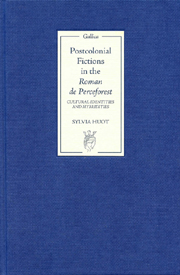Book contents
- Frontmatter
- Contents
- Acknowledgements
- Introduction
- PART I Founding Myths: Nature, Culture, and the Production of a British Kingdom
- PART II Heteronormative Sexuality and the Mission Civilisatrice
- 4 Compulsory Love
- 5 Marriage and the Management of Difference: Between Incest and Miscegenation
- 6 Sexual Violence, Imperial Conquest and the Bonds between Men
- PART III Greeks, Trojans, and the Construction of British History
- Conclusion
- Glossary of Proper Names in Perceforest
- Bibliography
- Index
5 - Marriage and the Management of Difference: Between Incest and Miscegenation
from PART II - Heteronormative Sexuality and the Mission Civilisatrice
Published online by Cambridge University Press: 05 February 2013
- Frontmatter
- Contents
- Acknowledgements
- Introduction
- PART I Founding Myths: Nature, Culture, and the Production of a British Kingdom
- PART II Heteronormative Sexuality and the Mission Civilisatrice
- 4 Compulsory Love
- 5 Marriage and the Management of Difference: Between Incest and Miscegenation
- 6 Sexual Violence, Imperial Conquest and the Bonds between Men
- PART III Greeks, Trojans, and the Construction of British History
- Conclusion
- Glossary of Proper Names in Perceforest
- Bibliography
- Index
Summary
We have seen that the cultural revival effected by the Greek rulers of Britain is indissociable from the institution of heterosexual love and marriage, and that Perceforest's reign is founded on the prohibition of rape. Equally important in the adventures of the first generation of the Greco-British knighthood is the balance that must be struck between endogamy, with its dangers of stagnation and isolation, and exogamy, with its dangers of corruption and pollution. The eradication of incest occupies two of the most important characters: the sublimely heroic Lyonnel, who marries the Scottish princess Blanchete, and young Gadifer, Blanchete's brother and the heir to the Scottish throne. The dire consequences of miscegenation, in turn, are illustrated in the disastrous marriage of Perceforest's son and heir Bethidés to Cerse, daughter of a Roman senator. This chapter will look at these complementary threats to Greco-British civilisation.
Cerse, the foreign queen whose devious Roman nature and loyalty to her native land spell the destruction of Britain, is probably modelled in part on the wicked queens of foreign birth described by Geoffrey of Monmouth. His Guenevere was a Roman princess, and although he does not mention her adultery with Lancelot, he does state that she colluded with Mordred against her husband. Geoffrey also cites the queen Renwein, Saxon wife of Vortigern, and comments darkly on that inter-ethnic, inter-faith marriage:
intrante sathana in corde suo. amauit puellam. & postulauit eam a patre suo. Intrauerat inquam sathanas in corde suo. quia christianus cum esset. cum pagana coire desiderabat. (VI.xii, p. 371) […]
- Type
- Chapter
- Information
- Postcolonial Fictions in the 'Roman de Perceforest'Cultural Identities and Hybridities, pp. 119 - 139Publisher: Boydell & BrewerPrint publication year: 2007



